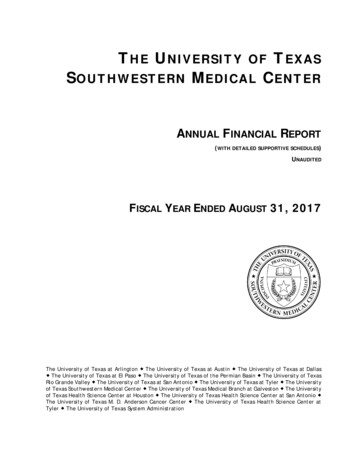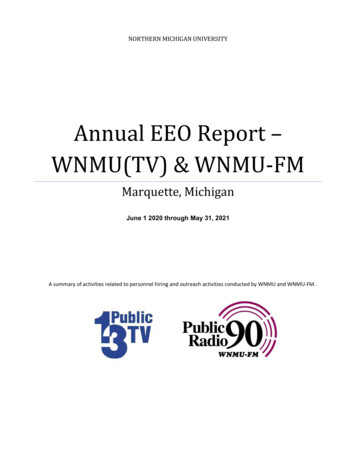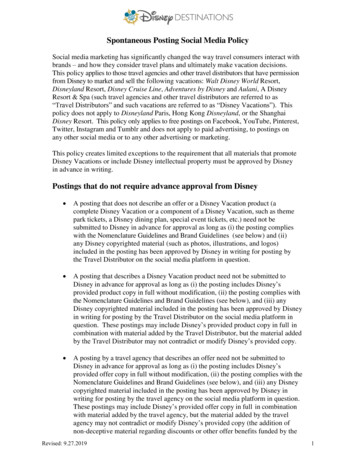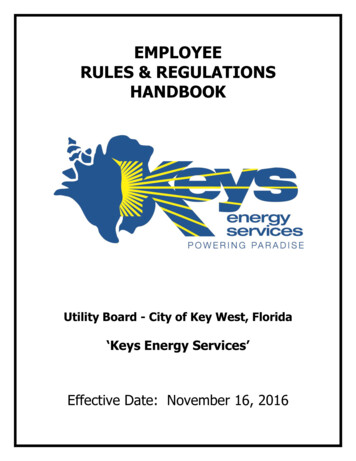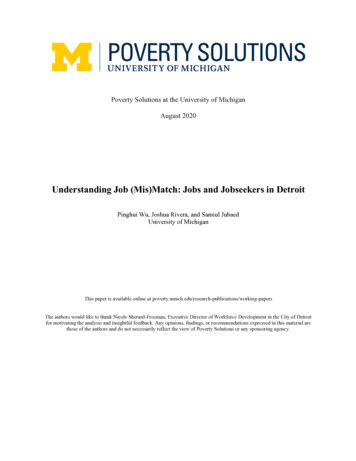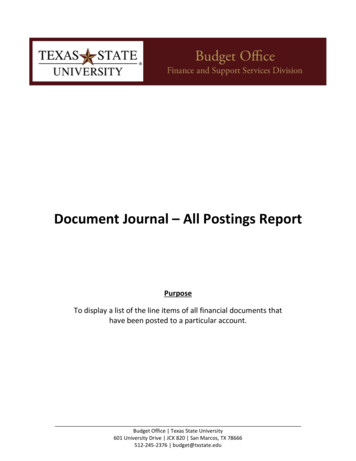
Transcription
Document Journal – All Postings ReportPurposeTo display a list of the line items of all financial documents thathave been posted to a particular account.Budget Office Texas State University601 University Drive JCK 820 San Marcos, TX 78666512‐245‐2376 budget@txstate.edu
Transaction code: ZFMRP RFFMEP1AXUsing this report, you can display a list of the line items of all financial documents that were posted to a particularaccount assignment. This report can be run for all types of accounts, including grants. This is information availableto a user via the Budget to Actual Report (ZBUDACT) and the Grant Summary Report (ZGM GRANT SUMMARY),however, a user must drill down to get to this line item detail—and depending on the volume of transactions, itcan be a bit time‐consuming. The major benefits of this report are:1) The ability to get to the details of actual expenditures without drilling down on each commitment item2) The ability to view and download data from multiple fiscal years.Note: You can also set up layouts that allow you to customize your view of the report.Enter fund numberEnter fund centerOptional:Enter commitment item group.Use. Funds Crosswalk forreference.Or enter a specific commitmentitem number (i.e. 730000) orrange of commitment itemsnumbers (4* for revenue/7* forexpenses.If reporting on a funded program, enter thefunded program number.Enter fiscal year and period range. You can crossfiscal years using this transaction.Delete maximum No. of HitsRecommended:Enter 54‐invoices and66‐transfer postingsFigure 1All Postings ReportPage 2 of 11
Selection Screen Parameters:FM Area: 754 (should always default)FM Account Assignment: Grant: Enter only if you have a grant (8*). Fund: You can enter the full 10 digit fund, but it is recommended that you enter the first six digits ofdesired fund with a (*) at the end, (i.e. 200001*, instead of 20000110XX) or a fund range If you enter the whole ten digit fund, be aware that if you intend to use a fund that beginswith a 750 or a 1, you need to use wild cards in the 7th and 8th digits before the fiscal year(i.e. 100005**XX). Funds Center: Enter the desired funds center or range of fund centers. Commitment Item:o Optional: If you want to report on a specific commitment item such as 730000 or all expense (7*)or all revenue (4*).o Be aware that you can use current *groups* that already exist such as the commitment itemgroup (i.e. 00BUDALL or 00BUDWEXCP) Variant: Do not use. Functional Area: Do not use. Funded Program:o This can be left blank. However, you may encounter security issues. Therefore, if you do not haveaccess to the funded programs in your area you need exclude funded programs (9*) or put NR* inthe field. If you do need to look at funded programs, enter the funded program in the box (or listof funded programs).Commitments/Actuals: Fiscal Year/Period: Enter the desired fiscal year(s) and period (s).o Note: you can cross fiscal years using this transaction.Example:Single PeriodsWithin a Fiscal YearAcross Fiscal YearsOptimization of database access: Maximum No. of Hits: Delete the defaulted 500.o This selection will limit the number of records selected to that number even if there are morethan 500 entries.Commts/Act: Value Type:o Enter value type 54 Invoices and 66 Transfer Postings ( IDT’s) for most instances of reporting suchas reconciling a period or running for prior year data analysis.All Postings ReportPage 3 of 11
oYou can run wide open if you want to look at all transactions including purchase requisitions,purchase orders, travel requisitions, etc. However, the data can be overwhelming, therefore werecommend to limit your search by only viewing 54s and 66s.Layout: Optional: you can choose a specific layout, otherwise the default layout is recommended if it is your firsttime running this report. The layout /TXSTATE 1Example selection parameters:Use the multiple selectionfeature to enter both“54” and “66” The greenindicator denotes thatthere is an additionalselection not visible onthe entry screen.Then, ExecuteAll Postings ReportPage 4 of 11
Results of transaction execution.Note that the results are in an ALV grid and users can filter, sort, hide columns, sub‐total, and create their owncustom layouts to meet their unique needs. Here is the link to the document that will show you how to use thevarious tools to best meet your reporting needs: Reporting FundamentalsReport results:Column Definitions: Fiscal Year‐Indicates the fiscal year based on the entry criteria for the line itemPeriod‐Indicates the period (month in the fiscal year) of the posted line itemPosting date – Indicates the date that the line item was posted in SAPRefDocNo – SAP Document Number.VT and Val. Type text – Identifies the type of document (i.e. invoice, funds commitment, profit transferposting, etc.). *Value types may have been identified in selection criteria. Definitions for Val. Type text:o Fund Pre‐Commitment: Encumbrances and used only for vacant positions. Created via PBC program that is run nightly. Automatically updates based on HR updates for position status, funding, costdistributions.o Funds Commitment: Automatically created and updated for salaries, travel, cell phone allowances. Most Common Subcategories of Funds Commitments: TV travel encumbrances PC payroll encumbranceso Funds Reservation: Departmental creation of encumbrance via the funds reservations function in sap forexpected operating expenses.o Parked Documents: Accounting process while documents are “on hold”. Once document is approved it will automatically become an invoice. Usually want to exclude parked documents unless you are looking for a “pending”transaction.o Invoices (54): Transactions that have been completed and have posted to your account. These itemshave been collected (revenue) or paid (expensed).All Postings ReportPage 5 of 11
o Profit Transfer Postings (66): IDT’s (Interdepartmental Transfers) and JV’s (Journal Vouchers) come through as profittransfer postings. Examples: Facilities request expenses Print shop expenses Telephone expenseso Purchase Requisitions: Encumbered funds not reviewed or approved by purchasing yet. These are initiated bythe department.o Purchase Orders: Encumbered funds reviewed and approved by Purchasing and in processing status. Asmerchandise comes in the invoices will be paid against the purchase order and reduce theencumbrance. Invoices paid will create an “actual” payment (eventually hitting the 54‐invoices value type).Type – Identifies the nature of the document in SAP (i.e. PK‐P‐Card, JV‐Journal Voucher, etc.).Reference – A reference for the document (for example, a vendor invoice number).Pred.doc.no – A predecessor document to the posting (for example, a funds commitment, purchaserequisition or a purchase order).Funds Center /Fund – The account assignment that is being credited or debited in this document.o This could be a cost center and fund, an internal order and fund, or a funded program and fund. Thedefault layout has the order and funded program shown to the far right of the layout.Funded Program – The funded program indicated on the entry criteriaOrder – The funded program indicated on the entry criteria. If NR* is used, this will be blank.Commt Item and Commitment item text – Pinpoints the posting to a particular assignment (GL) (for example,consumable supplies, Travel Out of State Incidental Expenses, etc.).Pymt Bdgt – Debit or credit amount of the document.Vendor – In the case of a vendor document, this is the SAP vendor number.Name 1 ‐ In the case of a vendor document, this is the SAP vendor name.Text – Line item text of the document, which gives further description of the posting.Header Text – Document header text applies to the entire document and provides a general description.Stat. Ind. – Indicates whether the document is statistical to budget so that the posting doesn’t affect thebudget balance.o It is best practice to exclude these postings from further analysis.All Postings ReportPage 6 of 11
Analysis:Reconciling a single account for 1 period Enter account information as described in the previous section.Enter the specific FY/Period that is being reconciledIf you want to report on a specific commitment item such as 730000 or all expense (7*) or all revenue (4*).o It is recommended that you use current *groups* that already exist such as the commitment itemgroup (i.e. 00BUDALL or 00BUDWEXCP)Execute reportIn the example above, the account in the entry criteria will pull in information for FY2020 period 1. The value types forreconciling posted transactions would be 54 invoices and 66 transfer postings ( IDT’s) only.All Postings ReportPage 7 of 11
ResultsThis is a collapsed view of the account noted above from All Postings by G/L for period 1.With All Postings, you can see all the drill down detail in one report (it’s summarized here for the purposes ofthis document).Here’s a collapsed view of Budget to Actual of the same account by G/L for period 1.With Budget to Actual, it’s already summarized, but you still have to drill down into each line item for moredetail.All Postings ReportPage 8 of 11
Generating, preparing and executing multi‐year data for analysis in Excel: Entry screen parameters:o Fund: or fund range using wild cards for the fiscal year digits 9 and 10. Example: 20000110**o Fund Center: Enter a single fund center or range of fund centers if looking more than one.o Commitment Item: Enter 7* for expenses only, 4* for revenue only, or leave blank if you want to pull in both. Also may use the commitment item group field if more appropriate. These are the samegroupings you pull in to your B2A report.o Funded Program: Leave blank, enter NR* or exclude funded programs if you get an error message.o Fiscal Year/Period: Put in the 1st year you want to see through the ending year you want to see. Period should be 1‐16 to pull in all transactions including those in reconciling periods foraccounting (13‐16)o Maximum number of hits: Make sure you delete the 500 that defaults in and leave this field blank.o Value Type: 55 Invoices and 66 Transfer postingsExample‐‐This is pulling in every revenue and expense for all accounts that are in Bookstore income generating accountAll Postings ReportPage 9 of 11
TIPS for organizing data and exporting to Excel Remove Statistical items by filtering out items marked with an X in the statistical item column. These are notbudget relevant.Hide the G/L columnSubtotal by commitment itemCompare result by commitment to Budget to Actual/Grant Summary or your shadow systemResearch detail by drilling down on the document numbers if needed.ExportingWithin the executed report you want to do the following: Remove statistical items by filtering out items marked with an X in the statistical item column. Hide the G/L column Remove the total in the PymtBdgt Column by highlighting the column and hitting the summation iconYour data is now ready for exporting to excel.To export Right click anywhere in the data set, then select Spreadsheet from the context menuOR‐select Menu List Export Spreadsheet:All Postings ReportPage 10 of 11
This will open the following dialog box. Select Excel and hit the green checkThen, select the location that you want the file to be saved. Rename the file.Choose the location you want to save your file, name the file, and hit save. Hit “allow” if any dialog boxes pop up.All Postings ReportPage 11 of 11
Encumbered funds reviewed and approved by Purchasing and in processing status. As . Pymt Bdgt - Debit or credit amount of the document. Vendor - In the case of a vendor document, this is the SAP vendor number. Name 1 ‐ In the case of a vendor document, this is the SAP vendor name. .



